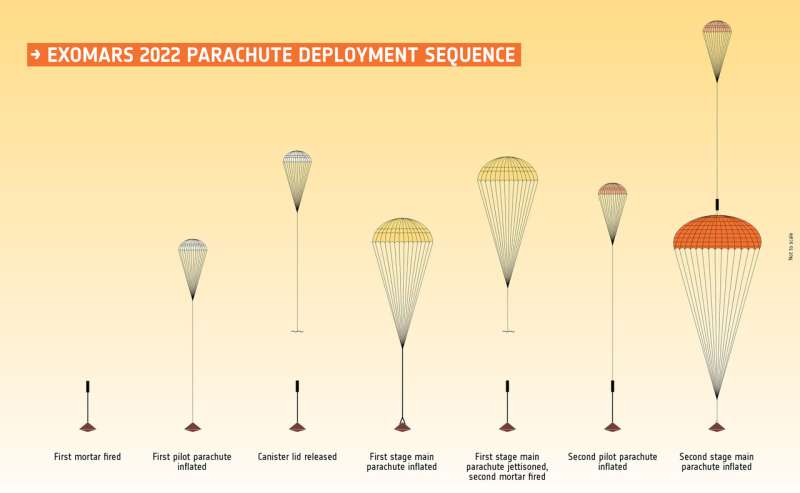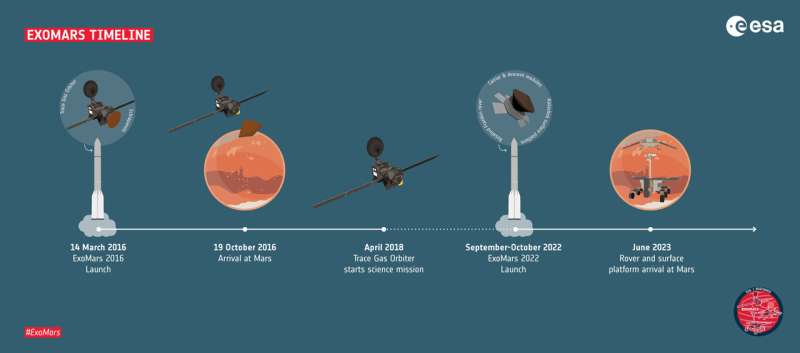The ExoMars parachute deployment sequence that will deliver a surface platform and rover to the surface of Mars in 2021 (following launch in 2020). The graphic is not to scale, and the colours of the parachutes are for illustrative purposes only. Credit: European Space Agency
The parachute system that will help deliver the Rosalind Franklin ExoMars rover to Mars has completed the first full-scale high altitude drop test with redesigned elements following two unsuccessful tests last year. Parachute extraction and deceleration proceeded as expected, the test vehicle landed safely and the test parachutes were recovered. However, some canopy damage occurred, pointing to the early inflation process for the focus of further improvements.
"Landing on Mars is extremely difficult, with no room for error," says ExoMars Programme Team Leader Francois Spoto. "The latest test was a good step forward but is not yet the perfect outcome we are seeking. Therefore, we will use the extensive test data we have acquired to refine our approach, plan further tests and keep on track for our launch in September 2022."
Parachute profile
The Rosalind Franklin rover and Kazachok surface platform are encapsulated inside a descent module that will be transported to Mars by a carrier module. The descent module is equipped with two parachutes—each with its own pilot chute for extraction—to help slow it down prior to landing on Mars. Once the atmospheric drag has slowed the descent module from around 21 000 km/h to 1700 km/h, the first parachute will be deployed. Some 20 seconds later, at about 400 km/h, the second parachute will open. Following separation of the parachutes about 1 km above ground the braking engines will kick in to safely deliver the landing platform onto the surface of Mars. The entire sequence from atmospheric entry to landing takes just six minutes.
The complete parachute descent system needs testing and verifying on Earth, for which high altitude drop tests play an essential role to help represent the low atmospheric pressure on Mars—a vital aspect when considering parachute inflation.
The ExoMars programme is a joint endeavour between Roscosmos State Corporation ESA. Apart from the 2022 mission, it includes the Trace Gas Orbiter (TGO) launched in 2016. The TGO is already both delivering important scientific results obtained by its own Russian and European science instruments and relaying data from NASA’s Curiosity Mars rover and InSight lander. The module will also relay the data from the ExoMars 2022 mission once it arrives at Mars. Credit: European Space Agency
New round of high altitude tests
The test conducted from Oregon, U.S. was delayed from March 2020 due to COVID-19 restrictions, forest fires and unfavorable wind conditions. Logistics re-planning and compatible weather finally enabled it to take place 9 November.
The test setup saw the drop test vehicle lofted to a height of 29 km in a stratospheric balloon.
The first main parachute had an upgraded parachute bag and a Kevlar reinforcement around the vent hem (that is, around the vent 'hole' in the centre of the parachute). The second main parachute had several reinforcement rings and an upgraded parachute bag, but not reinforced parachute lines, which are also planned. The fully upgraded second parachute will be used in a drop test at the Swedish Space Corporation Esrange facility in Kiruna, Sweden in mid-2021. The reinforcement rings were introduced to help prevent the dramatic tearing of the canopies witnessed during tests in 2019.
The timeline of the latest test, including extraction and deceleration, went exactly to plan. However, four tears in the canopy of the first main parachute and one in the second main parachute were found after recovery. The damage seemed to happen at the onset of the inflation, with the descent otherwise occurring nominally.
The team are now analysing the test data to determine further improvements for the next tests. Planning is underway for future tests in the first half of next year, to 'qualify' the complete parachute system ready for launch in September 2022.
Once safely in the Oxia Planum region of Mars in June 2023, the Rosalind Franklin rover will drive off the platform and begin its science mission. It will seek out geologically interesting sites to drill below the surface, to determine if life ever existed on our neighbour planet.
Provided by European Space Agency
























